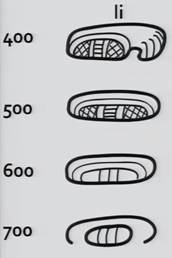| CMGG entry for syllabogram li
|
|
Variant: no-face flint
MC K&H JM TOK.p6.r5.c3
· The no-face flint variant is not the last historically attested form in the Late Classic – there was one later form with the smaller element more complete and independent of the bottom.
AT-E1168-lecture4.t0:07:40
|
|
Variant: face flint
MC K&H JM TOK.p6.r6.c1
MHD (Looper) MHD (Looper) MHD (Looper) MHD (Looper) QRG Stela D C14a QRG Stela E A14a QRG Stela E A17-B17a QRG Stela E C6 <4.HUL>:li:ya yi:li:a:<[ji]ya> <u:ti:ya>.<YAX:chi:hi:li> <wi:WITZ> u.<TI’:HUUN:li>
MHD (Looper) MHD (Looper) MHD (Looper) MHD (Looper) QRG Stela I QRG Stela J B13 QRG Stela J C12 QRG Stela E C6 16:HUL:li:ya 6.<<“DG”[ja]>:K’AL:li> K’AHK’.<TIL:li:wi> K’AHK’.<ti:li:wi>
· All sub-variants of this variant share a “face” (= three non-touching dots in a triangle pointing left, with the dot at the point of the triangle optionally touching the left end of the flint (= “face on the left; mouth optionally touching left wall”).
Sub-variants (2) · A. Comb: o The non-face end has a “comb”. o Just the teeth of the comb can be attached directly to the right wall. o The comb can also be a 90-degrees counter-clockwise rotated-U with cross-hatching inside. · B. Crossed bands: o The non-face end has crossed bands instead of the “comb”. o This sub-variant is common in QRG: § The comb sub-variant is also common in QRG. § But there are many occurrences of the crossed bands sub-variant in QRG, and most of the existing occurrences are from QRG (perhaps even only restricted to QRG?).
|
|
Variant: bird head with worm
DS-table TOK.p26.r1.c3
· Characteristics: o A worm half sticks out from the mouth of the bird. o Forehead ornament: a scroll / left feeler with protector and dotted reinforcement. · In modern Q’eqchi’ and Mopan, the word for the bat falcon (Falco rufigularis) is liklik, a bird which eats snakes (Hull, explained during MotT 2019 glyph workshop, devoted to the acrophonic origin of syllabograms)
|
|
Variant: helmet-or-snail A.
TOK.p18.r4.c4 MHD.ZD6.1 1719st
mayavase.com MHD (Graham) K8393 PSS NAR Stela 32 X3 u tz’i{h} ba li pa:pa:ma li:li
---------------------------------------------------------------------------------------------------- B.
MHD.ZD6.2 MHD (Moot) 'Lagartero Vase' C-E {u}TZ’I{h} ba li
---------------------------------------------------------------------------------------------------- Sub-variants (2): · A. Simple: perhaps a helmet(?) with two leaves under it, or a snail shell, with the snail’s two feelers sticking out? · B. Double: might be a “doubled” version of the single, with a mirror image added to the right (but without repetition of the dotted section on the right of the simple form).
Notes: · This is a rare but interesting variant of li. · A search on “blcodes contains ZD6” yields 5 hits. Extending the domain of the search to “All - Blocks” (i.e. including the Codices) does not yield any additional hits. · Of those 5 hits, 4 are on vessels and 1 is on a monument (NAR Stela 32). · Despite the very small number of occurrences, this glyph can be read with confidence. This is because: o It occurs as the “simple” sub-variant in K8393 PSS D-G, in the context of the standard formulaic word utz’ihbal = “it is the painting of”, at the position where li is expected. o It occurs as the “simple” sub-variant in NAR Stela 32 in the name pa-pa-ma-li-li è Papmalil. This is a name known from monuments elsewhere (CRC Altar 12, CRC Altar 13, and IXL Altar 1) where the name is spelled with very well-established variants of pa, ma, and (in particular) li. I.e., there is a substitution of this “helmet” variant for the other well-known forms of li. o It occurs as the “double” sub-variant in 'Lagartero Vase' PSS C-E, in the context of the standard formulaic word utz’ihbal = “it is the painting of”, at the position where li is expected.
|





